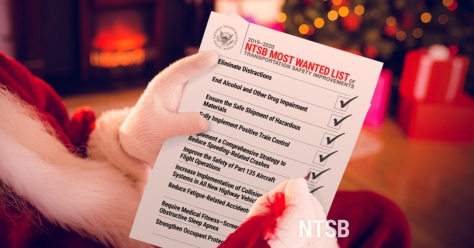By Chairman Robert L. Sumwalt
Every 2 years, the NTSB puts together a wish list, called our Most Wanted List (MWL) of transportation safety improvements. It comprises recommendations ripe for action by their recipients, which, if acted on, will bring safety benefits to all Americans.
Our wish list is not like some other traditional holiday wish lists. For one thing, we’re not asking who’s naughty and who’s nice; the stakes are too high for that. Regardless of whether you’re naughty or nice, you deserve access to safe transportation. Another difference is that a safety wish list is about things that transportation interests—government, industry, and others—are supposed to provide. Our list includes safety items that should “come standard,” not ones that we hope we’ll receive if we’re all really, really good travelers this year.

That being said, it’s still nice to see some “wishes” checked off our list this year, even if American travelers had every right to expect them. For instance, we recently acceptably closed the following recommendations to the Long Island Rail Road (LIRR) and the Metro-North Railroad, both part of New York’s Metropolitan Transit Authority:
- Safety Recommendation R-14-65, which asked the LIRR to screen and evaluate employees in safety-sensitive positions for sleep disorders, then treat those who tested positive.
- Safety Recommendations R-14-62 and R-14-64, which asked Metro-North to revise medical protocols and provide its employees in safety-sensitive positions a list of medications that engineers and conductors must avoid.
- Safety Recommendation R-17-9(to Metro-North) and R-17-10 (to a number of railroads, including Metro-North), which sought risk assessment and mitigation strategies at grade crossings with third-rail systems at or near the crossings. (Safety Recommendation R‑17‑10 remains classified “open” overall because other recipients have not yet completed action on it.)
What else can we scratch off our list?
In November, we closed Safety Recommendations P-18-5, -6, and -8 acceptably. These recommendations called for the management-of-change process to be used to identify natural gas system threats, and for professional engineers to be included in the engineering plan and constructability review processes as well as in public utility engineering drawings in Massachusetts.
In September, we closed Safety Recommendations P-18-1, -7, and -9 acceptably. These recommendations called for improved inspection programs, better records and documentation of natural gas systems, and procedures to mitigate risks identified during management-of-change operations.
In July, we announced the closure of eight MWL-related recommendations. Four (P‑17‑3, H‑15‑20, A-09-92, and H-09-18) were closed with acceptable action taken, one (P‑18‑3 ) was closed with acceptable alternate action taken, and one (M-16-28) was closed with a status of “exceeds recommended action.”
- P-17-3 called for Colonial Pipeline Company to address pipeline dent repairs and leak detection.
- P-18-3 called on Honeywell to address an issue with incorrectly installed mechanical tapping tee assemblies.
- H-15-20, to the National Limousine Association, addressed the need for passenger safety briefings about seat belt use in limousines.
- H-09-18, to the Federal Motor Carrier Safety Administration (FMCSA), addressed access to positive drug and alcohol test results and refusal determinations.
- A-09-92, to the Federal Aviation Administration, addressed the need for the helicopter emergency medical services to use the Aviation Digital Data Service Weather Tool as an official weather product.
- M-16-28, issued to the Passenger Vessel Association, called for a variety of actions to improve the safety of amphibious passenger vehicle operations, applying lessons learned in two amphibious passenger vehicle crashes.
As in most years, we did not get most of what we wished for on behalf of the traveling public; Even though these are safety measures the public is supposed to be able to count on, we understand. Many of our wish list items take a long time to achieve. These items, too numerous to name here, remain open.
Sometimes a recommendation, such as R‑04-7, is superseded by a subsequently issued recommendation (in this case, R-19-1).
And sadly, other recommendations must be closed unacceptably, such as H-12-29, issued to the FMCSA. This recommendation asked the FMCSA to establish an ongoing program to mitigate the risk of driver fatigue. That was one “gift” the traveling public really needed this year but did not receive.
Our 2019–2020 Most Wanted List includes the following broad items:
- Eliminate Distractions
- End Alcohol and Other Drug Impairment
- Ensure the Safe Shipment of Hazardous Materials
- Fully Implement Positive Train Control
- Implement a Comprehensive Strategy to Reduce Speeding-Related Crashes
- Improve the Safety of Part 135 Aircraft Flight Operations
- Increase Implementation of Collision Avoidance Systems in All New Highway Vehicles
- Reduce Fatigue-Related Accidents
- Require Medical Fitness—Screen for and Treat Obstructive Sleep Apnea
- Strengthen Occupant Protection
We celebrate the actions that have been taken this year to improve safety, but there’s plenty left to wish for. Take a look at our website for more information on the MWL and some of the recommendations still on our wish list.
Happy holidays, and may you receive everything you want (and need!) for the new year.





